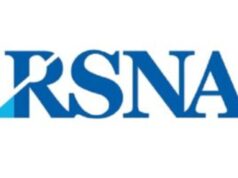
“With coronavirus disease 2019 (COVID-19), the demands and stresses on radiologists and physicians have increased dramatically. Even before this pandemic, the high prevalence of burnout, complex causes, and critical consequences had been widely reported,” write David Fessell and Cary Cherniss in the Journal of the American College of Radiology. “The need for effective strategies and tools [to manage radiologists’ mental health] is only increasing as both individuals and institutions navigate the current anxiety and uncertainty.” Here, Fessell outlines some “micro-practices” physicians can implement in their daily life to help cope with the additional stresses of working amidst a global pandemic.
With increased stress and anxiety comes an increased risk of decreased functioning and potential burnout. “Macro-practices”, including quality sleep, exercise, and nutrition, are essential for well-being. “Micro-practices” may also be helpful in preventing burnout and promoting emotional wellness. Such practices take just a few seconds to a few minutes. In a recent article, Cary Cherniss [Rutgers University, New Brunswick, USA] and I reviewed the evidence for four such practices: a self-wellness “check-in” during handwashing; the practice of “name it to tame it,” for our emotions; using a gratitude journal; and deep breathing for activating the parasympathetic nervous system to promote calmness and relaxation.1
“Micro-practices” can be anchored to already existing activities, such as hand-washing or logging into the PACS [picture archiving and communication system], to help us form healthy habits.2 Almost any recurring event can be a cue for a wellness check in: focusing on your breath and reflecting: am I well hydrated? Hungry? Emotionally or physically exhausted? Such quick and simple micro-practices are potentially possible even for the busiest radiologist. Activities outside our work lives can be cues as well—waiting in line or online, before answering the phone or a text, or even before brushing one’s teeth. Over time, such built-in wellness moments have the potential to shift one’s energy level and the tone of one’s day.
“Name it to tame it,” to paraphrase [neuropsychiatrist and author] Dan Siegel (University of California Los Angeles [UCLA] School of Medicine, Los Angeles, USA), has fMRI research to back it up. Such a practice can help us regulate our emotions, such as frustration and anger, to bring calm and ease.3 There are many helpful resources, including lists of the range of human feelings, which can help facilitate this process.4,5
An additional evidence-based practice that can aid well-being is the simple act of writing down three things one is grateful for several times a week.6,7 Sharing this practice with a “gratitude partner” can help expand the positive feelings and bring support and encouragement. Such practices can be extended to groups by starting meetings with “kudos” for recent achievements. Such group practices can help develop positive and dynamics relationships among team members.

Finally, a simple breathing technique known as diaphragmatic breathing has also shown promise for reducing stress and self-perceived anxiety.8 The practice is simple: inhale deeply by expanding the lungs downward rather than inhalation using the abdomen or ribcage alone. Inhale through the nose, pause and then slowly exhale through the mouth. Silent counting during inhalation and exhalation may be helpful to establish a respiratory rate of six to eight breaths per minute. This kind of slow, deep breathing is thought to increase para-sympathetic activation. Many other breathing techniques exist—explore them, and find one or more that resonates with you.9,10
Throughout one’s day there are likely many opportunities to take a deep breath or three: before the start of a read-out session, between cases, or on a bathroom break. These micro-practices may seem too small and inconsequential to do any good. Small changes are, however, doable and sustainable. Over time, building moments of mindfulness and gratitude, emotional regulation, and deep breathing into one’s day can increase the wellness in one’s life. Try one or more. If you are bringing more calm and peace to your world, it is highly likely your colleagues, family, and friends will benefit as well.
These micro-practices are not treatments for burnout. If you are experiencing burnout, please seek professional help. We need you happy, healthy, and thriving. These micro-practices are meant to complement other individual efforts such as mindfulness-based stress reduction (MBSR) and personal coaching. Having a robust tool box of practices that resonate with you can be an invaluable resource for navigating challenges including COVID-19, and beyond.
David Fessell is a radiologist at the University of Michigan Medical School, Ann Arbor, USA.
References
- Fessell D, Cherniss C. Covid-19 and Beyond: Micro-practices for Burnout Prevention and Emotional Wellness. J Am Coll Radiol.2020 Mar 24. pii: S1546-1440(20)30290-8. doi: 10.1016/j.jacr.2020.03.013. [Epub ahead of print].
- Saint S, Chopra V. How Doctors Can Be Better Mentors. HBR Oct 4, 2018. https://hbr.org/2018/10/how-doctors-can-be-better-mentors.
- Lieberman, M. D., Eisenberger, N. I., Crockett, M. J., Tom, S., Pfeifer, J. H., Way, B. M. Putting feelings into words: Affect labeling disrupts amygdala activity to affective stimuli. Psychological Science. 2007; 18:421–428.
- https://www.cnvc.org/training/resource/feelings-inventory
- David, Susan. Understanding Your Emotions. HBR, 11-10-16. https://hbr.org/2016/11/3-ways-to-better-understand-your-emotions. Accessed 3-31-20.
- Emmons, R. A., & McCullough, M. E. Counting blessings versus burdens: Experimental studies of gratitude and subjective well-being in daily life. Journal of Personality and Social Psychology. 2003:84;377–389.
- Sexton JB, Adair KC. Forty-five good things: a prospective pilot study of the Three Good Things well-being intervention in the USA for healthcare worker emotional exhaustion, depression, work-life balance, and happiness. BMJ Open, 2019; e022695.
- Hopper SI, Murray SL, Ferrara LR, Singleton JK. Effectiveness of diaphragmatic breathing for reducing physiological and psychological stress in adults: a quantitative systemic review. JBI Database of Systemic Reviews and Implementation Reports, 2019;17:1855-1876
- https://www.headspace.com/meditation/breathing-exercises?mod=article_inline
- https://www.webmd.com/balance/stress-management/stress-relief-breathing-techniques#1













